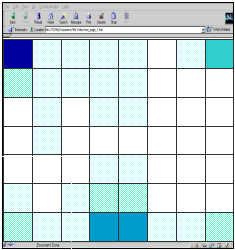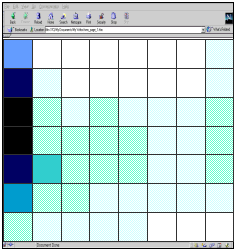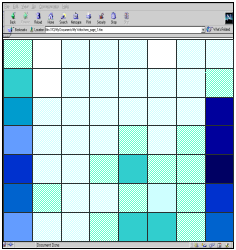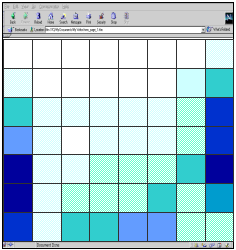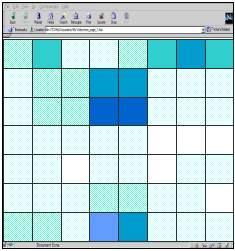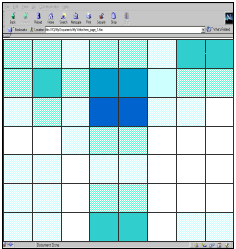Developing Schemas for the Location of Common Web Objects An essential ingredient in constructing the content of a website is knowing the typical users' mental model or 'schema' for the characteristic location of web objects on a website. Knowledge of this schema and constructing a site that reflects this should aid in the site's accessibility. This, in turn, should produce more accurate and faster information retrieval, as well as greater satisfaction with the site. However, little is known about the average users' schema for the location of web objects on a typical website. Any schema that is developed will depend to a large degree on the web experience of the user. That is, users may at first have a vague notion about the expected location of web objects on a site, but as they become more experienced with different types of websites they may develop a more precise schema for the placement of these objects. If there is a difference between novice and experienced users, this difference could impact website accessibility, depending upon the match between the users' schema and the placement of the web objects. This study sought to better understand users' schemas concerning the location of common web objects on a typical website by examining novice (less than one year of web experience) and experienced (three or more years of web experience) users. The web objects examined were: 1) grouping of links that internally connect web pages within the same site, 2) grouping of links to web pages that are external to a website, 3) "back to homepage" link, 4) internal search engine, and 5) advertisement banner(s). The two questions that were addressed in this study were: 1) Where do users expect common web objects to be located on a typical web page, and 2) is there a difference between novice and experienced users in the expected location of web objects? Knowing the answers to both questions should help web developers place these objects in the most expected location, as well as determine when they develop a specific schema for the location of these objects. Participants A total of 346 participants (121 males, 183 females) were examined. Of the participants, 109 were novices and 237 were experienced users. Most novices reported using the web a few times per month or less, while most of the experienced users used it a few times per week or daily. For both groups, the average age of the participants was 20 (range of 18 to 63), with almost two years of college. They also reported using the web primarily for educational purposes, followed closely by general surfing of the web. Procedure Using a depiction of a browser window that contained eight horizontal and seven vertical grid squares on a white background, participants were asked to place cards representing each of these objects where they expected them to be located on a typical web page. The cards could be placed horizontally, vertically, or overlap, and could be centered between the grid lines. The tabulation was accomplished by simply counting the number of times participants selected each square for each web object. The cards were also of different sizes, depending upon which web object they represented. This was to approximate their actual size on a web page. The internal and external link web objects occupied three squares, the internal search engine occupied two squares, and the rest of the objects occupied one square. The participants were given one card per web object, except for the advertisement object in which they were given two cards. This was done because commercial websites commonly have two or more advertisements per web page. Results The frequency in which each grid was selected for each web object was categorized (see Table 1). Each shade represents a specific range of percentages for the number of times each square was selected as an expected location for a particular web object. Each color indicates the percentage of times a particular square was selected by participants in either the novice or the experienced group. As
seen in the figures below, the participants developed distinct schemas
for the location of the web objects. Interestingly, these results
suggest that the development of these schemas occurred fairly quickly.
That is, participants with less than a year of web experience (novice)
generally had similar schemas for the location of most of the web
objects as those with three or more years of web experience
(experienced). Table 1. The darker the shade of blue, the greater percentage a particular square was selected.
GENERAL FINDINGS The study examined both novice and experienced participants' schemas for the typical location of common web objects. Basically, both novice and experienced participants had similar schemas for location of these objects. The results are as follows: 1) the internal web page links are expected to be located on the upper left side of a page, 2) the external web page links are generally expected to be located on the right side or lower left side of a page, 3) the "back to homepage" link is generally expected to be located at the top-left corner and the bottom-center of a page, 4) the internal search engine is generally expected to be located at the upper-center of a page, and 5) advertisements are generally expected to be located at the top of a web page. From these results, it is suggested that users quickly develop common schemas for these web objects, which underscore the need to place them in their expected location. Also, because there seems to be a quick learning curve for the location of these objects, websites can be designed without the need to place web objects in duplicate areas in order to accommodate novice users. Note: For a more detailed discussion concerning each web object, as well as an examination of all participants with web experience of six months or more, see the December 2000 issue of ITG's Internetworking. Note: A paper based on this work was presented at the Human Factors and Ergonomics Society's 45th (2001) Annual Meeting in Minneapolis/St. Paul, MN. |

